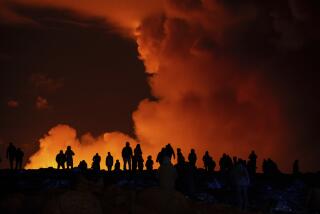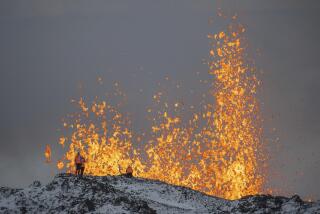Spacecraft Captures Io Volcano’s ‘Hot Breath’
- Share via
Jupiter’s moon Io is the most volcanically active world in the solar system. Several spacecraft that have orbited Io in past years have captured pictures of different volcanoes ejecting huge plumes of gas and particles.
In early August, NASA’s Galileo spacecraft captured a shot of the biggest volcanic plume ever seen. Gas and dust from the volcano rise about 310 miles above the surface.
The plume was a surprise to Jet Propulsion Laboratory volcanologist Rosaly Lopez, who said the site had shown little evidence of previous volcanic activity. “This new one sprang up suddenly,” she said.
The material comes from a previously undiscovered and still unnamed volcano near Io’s north pole. Galileo flew by the volcano on Aug. 5.
Galileo did more than just take pictures of the volcano. It also caught particles freshly released during the explosion--giving scientists a direct sample of extraterrestrial volcanic material to analyze.
“We’ve had wonderful images” of volcanoes before, said one of the mission’s scientists, Louis Frank of the University of Iowa. “But we’ve never caught the hot breath from one of them until now. Galileo smelled the volcano’s strong breath and survived.”
He characterized the particles as “snowflakes” made of frozen sulfur dioxide.
Io, the innermost of Jupiter’s four largest moons, is about the same size as Earth’s moon. Galileo will fly by the moon’s south pole on Oct. 16 to investigate another volcanic hot spot there.
(BEGIN TEXT OF INFOBOX / INFOGRAPHIC)
Jupiter Volcano
(text of infobox not included)






